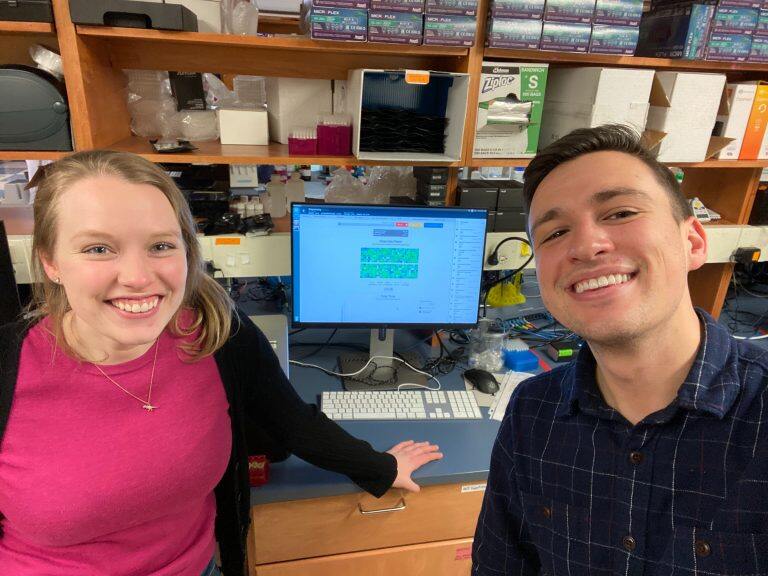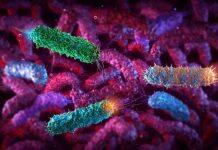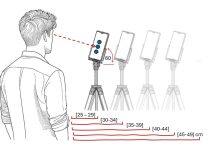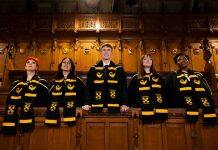Source: Graduate School, UW-Madison
By Meghan Chua
As graduate students at UW–Madison, Katarina Braun and Gage Moreno were already working in research labs to better understand viruses. So when SARS-CoV-2, the virus that causes COVID-19, began spreading rapidly around the world, Braun and Moreno were ready to make a quick pivot to working on the coronavirus.
Their work with sequencing the 2019 novel coronavirus has helped scientists better understand how the virus has traveled in Wisconsin and whether the protective equipment and safety protocols used in local hospitals are effective.


Braun, an MD and PhD student in the Medical Scientist Training Program and Cellular and Molecular Biology graduate program, studies the evolution of influenza viruses within and between hosts in Thomas Friedrich’s lab at the Wisconsin National Primate Research Center (WNPRC) AIDS Vaccine Research Laboratory. Moreno, a PhD student in the Cellular and Molecular Pathology graduate program and a member of David O’Connor’s lab also in the AIDS Vaccine Research Laboratory at WNPRC, uses metagenomic sequencing to identify viruses commonly found in different animals and evaluate whether they can jump to humans or other species.
In February, their labs began to get samples of SARS-CoV-2 to sequence, forming a collaborative team to better and more quickly learn about COVID-19.
The team uses genetic sequencing to uncover the subtle variations in the genetic sequence of SARS-CoV-2 viruses infecting individuals throughout the state of Wisconsin. As SARS-CoV-2 virus spreads, its genome is replicated many times and copying mistakes (mutations) accumulate within the viral genome. Genetic sequencing uncovers these differentiating mutations, which can be used to help track transmission routes and estimate viral introduction points within a community. To facilitate this process, after characterizing viral sequences, Braun and Moreno created a phylogenetic tree for SARS-CoV-2 in Wisconsin, which spatiotemporally maps the genetic relationships among these viruses.
Though preliminary, these sequencing efforts revealed viruses originating from the UW Health service area are more dissimilar from one another than would be expected if most infections were originating from already-infected individuals in the community.
“The mutations we’re seeing in the genome, they’re not found in other viruses that are in Dane County which indicates that these are all separate introductions and we’re not seeing sustained community transmission,” Moreno said. But Milwaukee is the opposite case, with a large number of very similar viruses, he said.
These sequencing techniques provide a look into how the virus is moving between people – or not moving between them, due to physical distancing measures.
“Being able to see that there hasn’t been a lot of evidence of mixing of the viruses that are circulating in Madison and Milwaukee – which are only 70 miles apart – is interesting,” Braun said.
Individual-level analysis has also led the team to useful conclusions. For example, they looked at a Madison healthcare worker (HCW) who tested positive for COVID-19 after working with coronavirus patients. The lab got samples from the patient, the HCW, and one of the HCW’s family members who had recently come down with a fever and respiratory symptoms. They sequenced each of these samples to determine whether the HCW got the virus from their patients or the family member. By comparing the individual viral sequences, they were able to determine that the HCW was unlikely to have been infected within the hospital.
“It was encouraging to see that, at least in this case, there was no breach of infection control practices as the source of infection was most likely in the community,” Moreno said.
The lab has made its sequencing data and preprints (articles detailing their findings that haven’t yet gone through a peer review process, which can be lengthy) available on the web in real time. They post reports to the “CoVen” – an open research portal – and submit data to Nextstrain (led by Trevor Bedford at the Fred Hutch Cancer Research Center), which tracks the spread and evolution of SARS-CoV-2 around the world. Braun said that having access to sequencing data from other labs outside of Wisconsin was essential for the work their lab has been able to do. She and Moreno credit their advisors Friedrich and O’Connor with being leaders in providing open access data to benefit the scientific community and the community at large.
“We want to find ways that scientists across institutions and across the world can collaborate to find the best vaccines, the best treatments, the best approaches, rather than competing with each other,” Friedrich said in a UW Now video from April 28.
Friedrich and O’Connor used this same open data approach when working on the Zika virus outbreak in 2016 and continuing now with coronavirus.
“I’ve looked up to them in terms of how they’ve responded to this pandemic, and I feel lucky to be in a lab where I have had the opportunity to participate in the scientific community’s response to this virus,” Braun said.
Moreno said the collaborative environment at UW–Madison made the quick pivot from what they were working on before to the coronavirus, possible.
“Kat and I are in different labs, but it was no question from the start of it that we would combine our efforts to answer these questions. It just seemed like the obvious choice,” he said.
Other graduate students, undergraduate students, researchers, and administrators with the lab have also been key in supporting the sequencing work and getting approvals to work with and make available individual-level sequencing data.







































